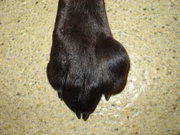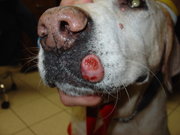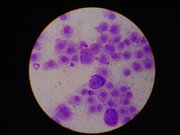 Mast cell tumor of the paw
Mast cell tumor of the paw
|
From Wikipedia the free encyclopedia, by MultiMedia |
A Mastocytoma is an accumulation or nodule of mast cells that resembles a tumor. In Dogs and cats this collection of mast cells is actually a mast cell tumor. A mast cell originates from the bone marrow and is normally found throughout the connective tissue of the body. It is associated with allergic reactions because it releases histamine. A mast cell tumor is a common malignant tumor of the skin in older Dogs and cats.
 Mast cell tumor of the paw
Mast cell tumor of the paw
 Mast cell tumor on the lip
Mast cell tumor on the lip
 Mast cell tumor cytology
Mast cell tumor cytology
Most mast cell tumors are small, raised lumps on the skin. Some are hairless, ulcerated, or itchy. They are usually solitary. In rare cases a highly malignant tumor is present, and symptoms may include loss of appetite, vomiting, diarrhea, and anemia. The presence of these symptoms usually indicates mastocytosis, which is the spread of mast cells throughout the body. Release of a large amount of histamine at one time can result in ulceration of the stomach and duodenum, or disseminated intravascular coagulation.
A needle aspiration biopsy of the tumor will show a large number of mast cells. This is sufficient to make the diagnosis of a mast cell tumor. However, a surgical biopsy is required to find the grade of the tumor. The grade depends on how well the mast cells are differentiated, from grade I to grade III. The disease is also staged.
X-rays, ultrasound, or lymph node, bone marrow, or organ biopsies may be necessary to stage the disease.
Removal of the mast cell tumor through surgery is the treatment of choice. Antihistamines such as diphenhydramine are given prior to surgery to protect against the effects of histamine released from the tumor. Wide margins (two to three centimeters) are required because of the tendency for the tumor cells to be spread out around the tumor. If complete removal is not possible due to the size or location, additional treatment such as radiation therapy or chemotherapy may be necessary. Prednisone is often used to shrink the remaining tumor portion. H2 blockers such as cimetidine protect against stomach damage from histamine.
Mast cell tumors that are grade I or II that can be completely removed have a good prognosis. Any mast cell tumor found in the gastrointestinal tract, prepuce, paw, or around the anus has a guarded prognosis. Tumors that have spread to the lymph nodes or other parts of the body have a poor prognosis. Any Dog showing symptoms of mastocytosis or with a grade III tumor has a poor prognosis. Boxers have a better than average prognosis because of the relatively benign behavior of their mast cell tumors.
Siamese cats are at an increased risk for mast cell tumors. Gastrointestinal and splenic involvement is more common in cats. Diagnosis and treatment are similar to the Dog. The prognosis for solitary skin tumors is good, but guarded for tumors in other organs.
Dogs, made by MultiMedia | Free content and software
This guide is licensed under the GNU Free Documentation License. It uses material from the Wikipedia.